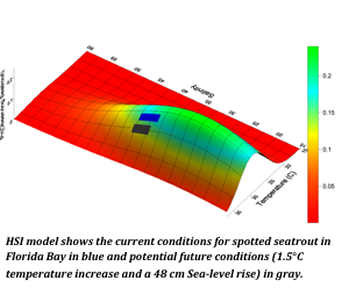Global climate change will have profound implications for marine ecosystems, as well as the economic
and social systems that depend upon them. Through this integrated, multidisciplinary project, we
examine the effect of future climate and water management conditions on the sustainability of key
commercial and recreational fishery species focusing upon Florida Bay, a major nearshore nursery
ground for many fishery species. To accomplish this goal we have assembled a diverse team with partners
at NOAA's Southeast Fisheries Science Center (NOAA/SEFSC), University of Miami's Rosenstiel School of
Marine and Atmospheric Science, and Florida International University.

The physical oceanography, including temperature and salinity, is simulated with a nested high-resolution
model of SW Florida implemented with the Regional Oceanic Modeling System (ROMS). The circulation of
the ROMS model presently is forced at the surface by the NCEP North American Regional Reanalysis (NARR)
atmospheric model. We use CMIP5 climate model outputs for new simulations that will be coupled with
ecological models to predict the impact of interacting climate change and water management scenarios
on south Florida nursery habitat. ROMS case scenario output will be used as inputs into habitat suitability
index (HSI) models, a mechanistic trophic model, and a connectivity model. Species modeled will be pink
shrimp (Farfantepenaeus duorarum), spotted seatrout (Cynoscion nebulosus), and gray snapper (Lutjanus griseus),
which support valuable south Florida commercial and recreational fisheries. The HSI models will predict how
interacting effects of climate change and water management alter suitable nursery habitat area available
to target species. Relating recruitment strength to suitable habitat area will quantify population impacts.
An expanded existing mechanistic trophic model for Florida Bay will examine trophic interactions among
these species, allowing determination of how interacting water management/climate changes might affect
populations of these species, their prey, or other target species. Simulation outputs will be used to
produce decision support tools depicting the impact of these scenarios on the vulnerability and health
of south Florida's marine ecosystem.
|
